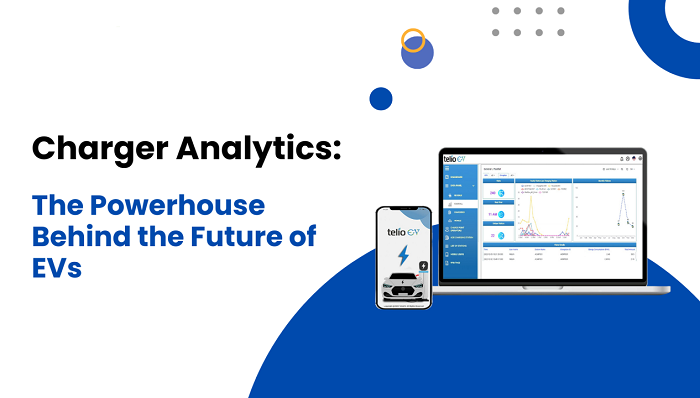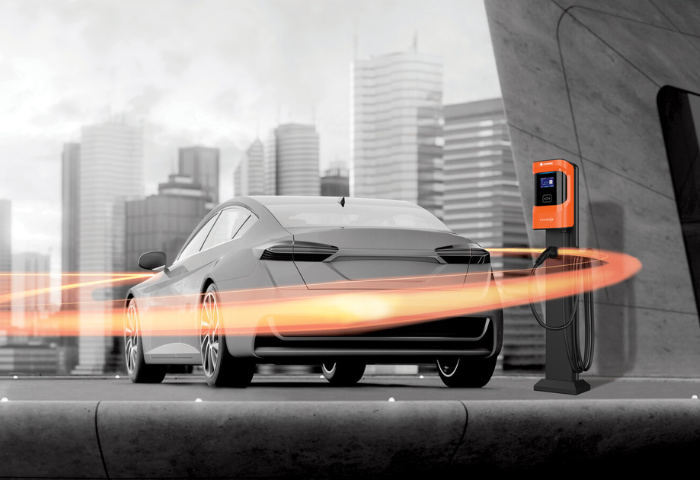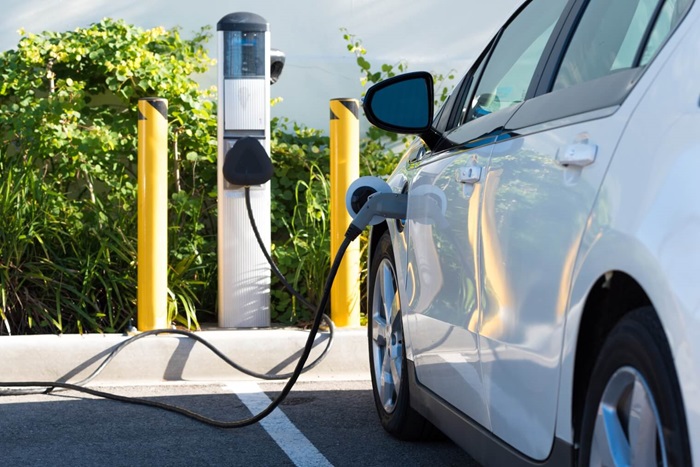Introducing the NEMA 14-50 Plug EV Charger: Power Up Your Electric Vehicle with Ease
The NEMA 14-50 Plug EV Charger offers a convenient and efficient solution for charging your electric vehicle at home. This powerful charger utilizes the readily available NEMA 14-50 outlet, eliminating the need for costly electrical upgrades. With its user-friendly design and compatibility with most EVs, the NEMA 14-50 Plug EV Charger provides a hassle-free charging experience.
Definition and Overview
The NEMA 14-50 plug is a type of electrical plug commonly used for high-power applications, such as electric vehicle (EV) charging. It is standardized by the National Electrical Manufacturers Association (NEMA) in the United States. The “14” in NEMA 14-50 refers to the configuration of the plug and receptacle, while the “50” indicates that it is rated for a maximum current of 50 amps.
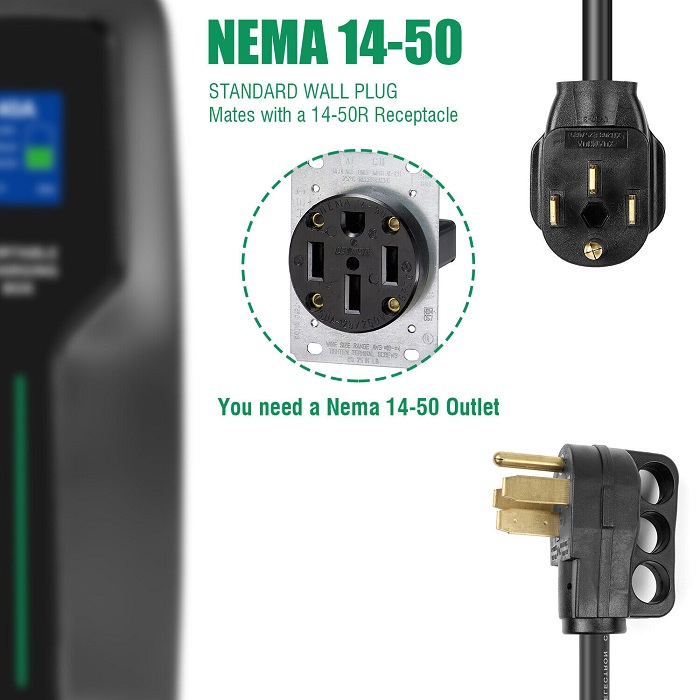
The NEMA 14-50 plug consists of four prongs arranged in a rectangular pattern: two hot prongs (usually black or red), one neutral prong (typically white), and one ground prong (usually green). This configuration allows for both 120-volt and 240-volt connections, making it versatile for various applications.
When it comes to electric vehicles, the NEMA 14-50 plug is often used for Level 2 charging. Level 2 charging provides faster charging compared to standard Level 1 charging, as it operates at higher voltage and current levels. With the NEMA 14-50 plug, EV owners can easily install a Level 2 charging station at home or other locations where the plug is available.
Benefits of using the NEMA 14-50 plug for EV charging include:
- Faster Charging: Level 2 charging with the NEMA 14-50 plug allows for quicker charging times compared to Level 1 charging, which typically uses a standard household outlet.
- Convenience: Many EV owners find it convenient to charge their vehicles at home using a Level 2 charging station with a NEMA 14-50 plug. It eliminates the need to visit public charging stations regularly and allows for charging overnight or during off-peak hours.
- Cost-Effectiveness: While installing a dedicated Level 2 charging station may require some upfront investment, using the NEMA 14-50 plug can be a cost-effective solution compared to other charging options. It leverages existing electrical infrastructure in homes or commercial buildings.
- Compatibility: The NEMA 14-50 plug is a widely adopted standard in the United States, making it compatible with many EV charging stations and electrical outlets. This compatibility ensures that EV owners have access to charging infrastructure in various locations.
- Safety: NEMA standards ensure that electrical devices and connections, including the NEMA 14-50 plug, meet specific safety requirements. When installed correctly and used with appropriate equipment, the NEMA 14-50 plug provides a safe and reliable charging solution for electric vehicles.
Types of NEMA 14-50 Plugs
NEMA 14-50 plugs come in two main types: NEMA 14-50R and NEMA 14-50P.
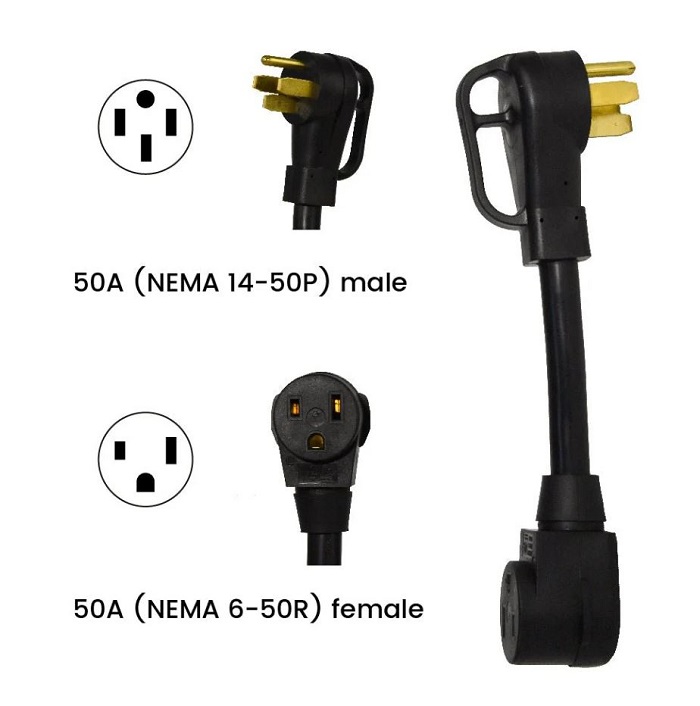
- NEMA 14-50R: The “R” in NEMA 14-50R stands for “receptacle.” This type of plug is designed to be installed in an electrical outlet, providing power for devices such as electric vehicle charging stations. NEMA 14-50R receptacles have four slots to accommodate the prongs of the corresponding NEMA 14-50P plug.
- NEMA 14-50P: The “P” in NEMA 14-50P stands for “plug.” This type of plug is attached to the power cord of electrical devices, such as EV charging stations, allowing them to be connected to NEMA 14-50R receptacles. NEMA 14-50P plugs have four prongs that fit into the slots of NEMA 14-50R receptacles.
Compatibility with different EV models:
Many electric vehicle manufacturers provide charging cables with NEMA 14-50P plugs as an option for Level 2 charging. However, compatibility can vary depending on the specific EV model. It’s essential for EV owners to check their vehicle’s specifications and charging options to ensure compatibility with NEMA 14-50 plugs.
Features of NEMA 14-50 plugs for EV charging:
- High Power Output: NEMA 14-50 plugs are capable of delivering high power levels, making them suitable for Level 2 charging of electric vehicles.
- Versatility: These plugs support both 120-volt and 240-volt connections, providing flexibility for charging at different power levels.
- Standardization: NEMA 14-50 plugs adhere to standardized specifications set by the National Electrical Manufacturers Association (NEMA), ensuring compatibility and interoperability with various EV charging stations and electrical outlets.
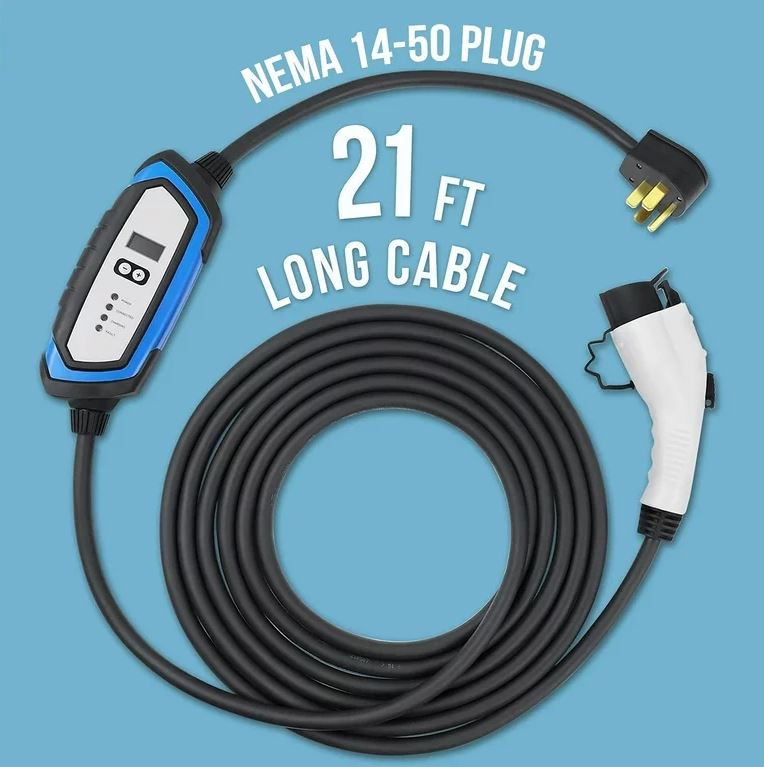
Durability and safety considerations:
NEMA 14-50 plugs are built for durability with a robust design for high-power applications. However, for safe EV charging:
- Ensure the NEMA 14-50 outlet and wiring are properly installed and rated for your EV charger’s amperage.
- Use a UL-listed EV charger that adheres to safety standards.
- Regularly inspect the plug and cable for any signs of damage.
Installing a NEMA 14-50 Outlet for EV Charging: Important Considerations
While a NEMA 14-50 outlet can be tempting for DIY EV charging, it’s strongly recommended to hire a licensed electrician for the installation. Working with high voltage electricity poses significant safety risks. However, here’s an overview of the process and safety precautions:
Requirements for installing a NEMA 14-50 outlet:
- Electrical Permit: Most localities require a permit for installing a new high-voltage outlet.
- Circuit Capacity: Your existing electrical panel needs to have sufficient capacity (amps) to handle the additional load of the EV charger. This might involve upgrading your panel or circuit.
- Wiring: The outlet needs proper gauge wire (typically 6 AWG copper) to handle the amperage.
- Ground Fault Circuit Interrupter (GFCI): While not always required by code for EV chargers, a GFCI can provide additional safety.
A step-by-step guide for installing a NEMA 14-50 plug for EV charging:
- Turn off Power: Before starting any work, turn off the power supply to the circuit at the main breaker panel.
- Select Location: Choose a suitable location for the outlet, ensuring it’s easily accessible for charging your EV.
- Install Outlet Box: Mount the outlet box securely to the wall or surface according to electrical codes and regulations.
- Run Wiring: Route the appropriate wiring from the circuit breaker panel to the outlet location, ensuring proper support and protection.
- Connect Wiring: Strip the insulation from the ends of the wiring, then connect the black (hot), white (neutral), and green (ground) wires to the corresponding terminals on the NEMA 14-50R receptacle. Tighten the terminal screws securely.
- Secure Receptacle: Carefully insert the NEMA 14-50R receptacle into the outlet box, ensuring it is aligned correctly. Secure the receptacle to the outlet box using the screws provided.
- Double-check Connections: Verify that all wiring connections are secure and properly insulated.
- Close Outlet Box: Install the outlet box cover securely, ensuring it provides adequate protection.
- Turn on Power: Restore power to the circuit at the main breaker panel.
- Test Outlet: Use a voltage tester to check for the presence of voltage at the outlet. Ensure proper functioning before connecting any devices, such as an EV charger.
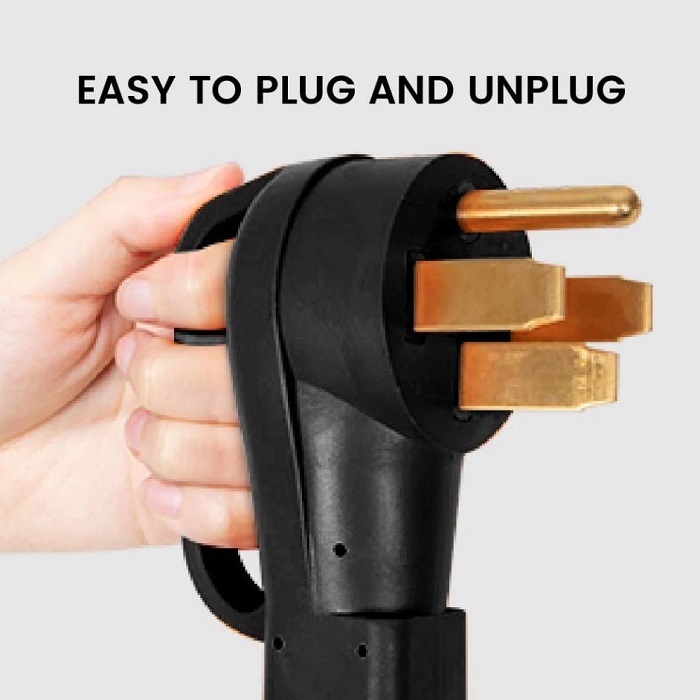
Common wiring configurations for a NEMA 14-50 plug:
- Black (hot) wire to brass terminal
- White (neutral) wire to silver terminal
- Green (ground) wire to green terminal
Safety precautions during the installation process:
- Always turn off power at the main breaker panel before working on electrical circuits.
- Use appropriate personal protective equipment, such as safety glasses and insulated gloves.
- Follow electrical codes and regulations applicable to your location.
- Ensure proper grounding and insulation of all wiring connections.
- If you’re not comfortable with electrical work, consider hiring a qualified electrician to perform the installation.
This information is for general understanding only. Do not attempt to install a NEMA 14-50 outlet yourself. Leave it to a licensed electrician to ensure a safe and proper installation for your EV charging needs.
NEMA 14-50 Plug Charging Speed and Efficiency
The charging rate of a NEMA 14-50 plug for electric vehicles (EVs) falls under Level 2 charging, which generally provides faster charging than Level 1 charging but slower than Level 3 (DC fast charging).
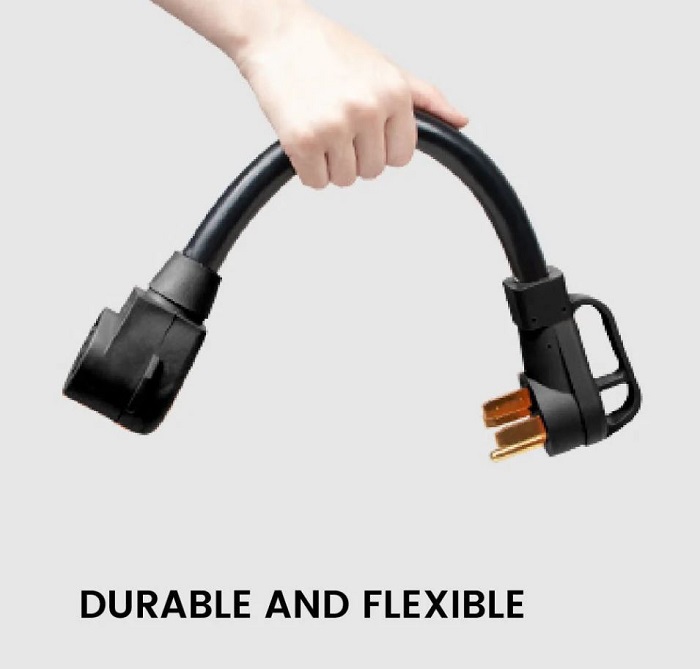
Charging Rate Comparison:
- NEMA 14-50 Level 2 Charger: With a maximum output of 240 volts and 50 amps, a NEMA 14-50 Level 2 EV charger can deliver around 7.2 kW of power. This translates to charging speeds of roughly 25-30 miles per hour for most EVs.
- Standard 120V Outlet (Level 1): This common household outlet provides 1.4 kW of power, resulting in much slower charging speeds, typically around 3-5 miles of range per hour.
- DC Fast Charging: DC fast chargers deliver high-direct current at stations, offering significantly faster charging rates (50 kW or more) but are intended for occasional use, not regular charging.
Factors Influencing Charging Speed with NEMA 14-50:
- EV Charger Capability: Not all NEMA 14-50 chargers are created equal. While the outlet can support 50 amps, the charger itself might be limited to a lower output (e.g., 32 amps).
- Car’s Onboard Charger: The onboard charger in your EV ultimately determines the maximum charging rate it can accept. Some EVs might have limitations below 7.2 kW.
- Battery Health and Temperature: Battery temperature and overall health can affect charging speed. Extremely hot or cold batteries may slow down charging.
Energy Efficiency with NEMA 14-50:
- Minimal Loss: NEMA 14-50 delivers power efficiently with minimal energy loss due to the higher voltage (240V) compared to a standard 120V outlet.
- Smart Charging: Look for EV chargers with smart features that can optimize charging based on factors like time-of-day electricity rates.
Overall, while the NEMA 14-50 plug provides a faster charging option compared to Level 1 charging, it may not match the rapid charging speeds offered by Level 3 DC fast chargers. However, it strikes a balance between charging speed, convenience, and energy efficiency for many EV owners, especially for overnight charging at home or during extended parking periods.
Compatibility with Electric Vehicles
Many electric vehicles (EVs) are compatible with the NEMA 14-50 plug for charging, making it a versatile option for EV owners. Some popular EV models that are compatible with the NEMA 14-50 plug include:
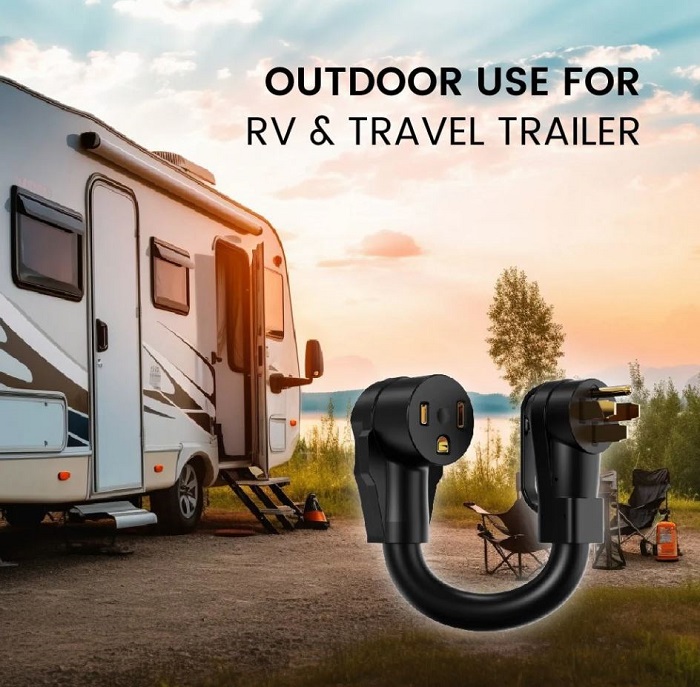
- Tesla Models (with appropriate adapters):
- Tesla Model S
- Tesla Model 3
- Tesla Model X
- Tesla Model Y
- Chevrolet Bolt EV
- Nissan Leaf (with appropriate adapters)
- Ford Mustang Mach-E
- Audi e-tron
- Porsche Taycan
- BMW i3
- Hyundai Kona Electric
Adapter options are available for EVs that do not have native compatibility with the NEMA 14-50 plug. For example:
- Tesla vehicles: Tesla offers a range of adapters, including the NEMA 14-50 adapter, which allows Tesla owners to plug into NEMA 14-50 outlets for charging.
- Other EVs: Third-party adapters may be available for specific EV models to enable charging with the NEMA 14-50 plug. These adapters typically convert the EV’s charging port to accept the NEMA 14-50 plug.
Benefits of choosing EVs that can use the NEMA 14-50 plug for charging include:
- Faster Charging: NEMA 14-50 chargers offer significantly faster charging speeds compared to a standard 120V outlet, reducing charging time at home.
- Convenience: With a NEMA 14-50 charger installed at home, you can conveniently charge your car overnight for a full battery every morning.
- Potential Cost Savings: Regularly relying on public charging stations can add up. Home charging with a NEMA 14-50 setup might be a more cost-effective solution in the long run, depending on electricity rates.
Cost and Budgeting for NEMA 14-50 Plug Charging
The cost of installing a NEMA 14-50 outlet can vary depending on several factors, including labor rates, local electrical codes, existing wiring conditions, and the distance from the electrical panel.

- Average Installation Cost:
The cost of installing a NEMA 14-50 outlet can vary depending on several factors, including:
- Location (geographic area and electrician rates)
- Complexity of the installation (distance from the electrical panel, need for additional wiring)
- Permitting requirements in your area
Generally, you can expect the cost to range from $500 to $800 [refer to previous conversation for estimation].
- Cost Savings of Using NEMA 14-50 Plug for EV Charging:
Reduced Charging Equipment Cost: Compared to installing a dedicated Level 2 EV charging station, using a NEMA 14-50 plug can result in cost savings on equipment. Level 2 EV charging stations with NEMA 14-50 plugs are generally less expensive than hardwired stations.
Versatility: The NEMA 14-50 plug allows EV owners to utilize existing electrical outlets, reducing the need for additional infrastructure investment. This versatility can lead to cost savings, especially for homeowners who already have NEMA 14-50 outlets installed or are willing to install them for multiple uses beyond EV charging.
Time-of-Use Savings: Some utility companies offer time-of-use electricity rates, where charging during off-peak hours can result in lower electricity costs. By taking advantage of these rates, EV owners can further reduce their charging expenses.
- Budgeting Considerations for Switching to NEMA 14-50 Plug Charging:
Upfront Installation Cost: Budgeting for the initial installation of a NEMA 14-50 outlet is essential. Homeowners should obtain quotes from licensed electricians to estimate the installation cost accurately.
Long-Term Savings: Consider the long-term savings potential of using a NEMA 14-50 plug for EV charging compared to alternative charging options. Calculate the potential savings in electricity costs and equipment expenses over the lifespan of the EV.
Rebates and Incentives: Check for available rebates, incentives, or tax credits for EV charging infrastructure installations. Some utility companies and government agencies offer financial incentives to encourage the adoption of EVs and EV charging infrastructure, which can offset installation costs.
Maintenance and Operating Costs: Factor in ongoing maintenance and operating costs associated with EV charging, such as electricity consumption and occasional maintenance of the charging equipment.
Comparison with Other Charging Options
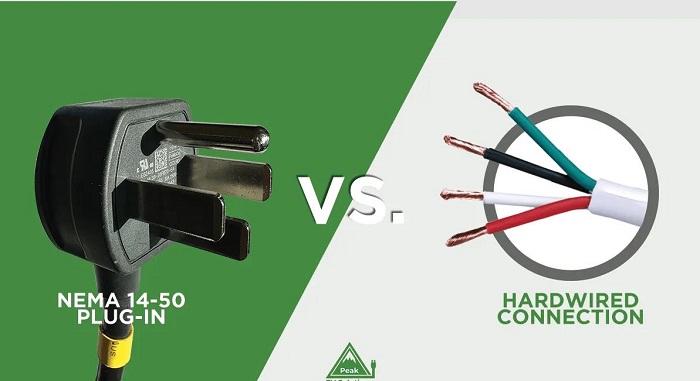
1. Level 1 Charging (Standard 120v outlet)
Advantages:
- Universal Accessibility: Can be performed using standard household outlets, making it accessible virtually anywhere there is a power source.
- Low Upfront Cost: No additional equipment or installation costs are required beyond a standard charging cable.
- Suitable for Overnight Charging: Ideal for overnight charging scenarios, where the slow charging rate is less of a concern.
Disadvantages:
- Slow Charging Speed: Level 1 charging is the slowest option available, making it impractical for those with higher daily driving needs or for quick top-ups.
- Limited Range: The slow charging speed may restrict the range of electric vehicles, particularly those with larger battery capacities.
- Dependence on Outlet Availability: Charging times can vary depending on the quality and capacity of the outlet, and some outlets may not provide adequate power for efficient charging.
2. Level 2 Charging (240v outlet):
Advantages:
- Faster Charging: Significantly faster than Level 1 charging, making it suitable for daily charging needs and longer trips with shorter downtime.
- Convenience: Dedicated Level 2 charging stations are increasingly available in homes, workplaces, and public locations, offering convenience and reliability.
- Enhanced Range Flexibility: With faster charging speeds, Level 2 chargers provide greater flexibility for longer journeys without extended charging stops.
Disadvantages:
- Installation Cost: Installing a dedicated Level 2 charging station may require professional installation and can be more expensive compared to utilizing existing outlets for Level 1 charging.
- Space Requirements: Dedicated Level 2 charging stations may require additional space, both for the charging unit itself and for the electrical connections.
- Availability: While Level 2 charging stations are becoming more common, they may not be as universally accessible as standard outlets for Level 1 charging.
3. NEMA 14-50 Plug Charging (Specific type of Level 2 Charger):
Advantages:
- Faster Charging: Compared to Level 1 charging, NEMA 14-50 plug charging provides significantly faster charging speeds due to its higher voltage and amperage.
- Versatility: The NEMA 14-50 outlet is commonly used for various purposes beyond EV charging, such as RVs, welders, and appliances, making it relatively easy to find or install.
- Moderate Cost: While installing a dedicated NEMA 14-50 outlet may require some upfront investment, it generally costs less than installing a Level 2 charging station.
Disadvantages:
- Limited Speed: Although faster than Level 1 charging, NEMA 14-50 plug charging is slower compared to Level 2 charging, which may not be ideal for those with higher daily mileage requirements.
- Installation Complexity: While the outlet is relatively easy to find, installing a NEMA 14-50 outlet may require professional electrical work, especially if your home lacks the necessary wiring.
- Potential Overloading: Continuous high-amperage charging from the NEMA 14-50 outlet may strain the home’s electrical system, especially if other high-power appliances are in use simultaneously.
4. Long-term Cost-effectiveness of NEMA 14-50 Plug
The long-term cost-effectiveness of using a NEMA 14-50 plug for EV charging depends on various factors, including:
- Usage Patterns: If you have moderate to low daily driving needs and can charge overnight, the lower upfront cost and moderate charging speed of the NEMA 14-50 plug may make it cost-effective over time compared to installing a Level 2 charging station.
- Electricity Rates: The cost of electricity in your area will impact the overall cost-effectiveness. Some utilities offer favorable rates for EV charging during off-peak hours, which can make any charging option more cost-effective.
- Vehicle Efficiency: The efficiency of your EV and its battery capacity will influence how frequently and how much you need to charge, affecting overall charging costs.
- Installation Costs: While the NEMA 14-50 plug may have lower upfront installation costs compared to a Level 2 charging station, it’s essential to consider any potential electrical upgrades or modifications needed for safe and efficient charging.
In summary, while the NEMA 14-50 plug offers faster charging than Level 1 options and may be more cost-effective in certain scenarios, it may not provide the same convenience and flexibility as Level 2 charging, especially for those with higher daily driving needs or longer trips. Evaluating your individual usage patterns, upfront costs, and long-term charging requirements will help determine the most cost-effective charging solution for your EV.
Maintenance and Troubleshooting
Maintaining a NEMA 14-50 plug and outlet ensures safe and efficient charging for electric vehicles (EVs). Here are some regular maintenance tips, troubleshooting advice for common issues, and safety practices.
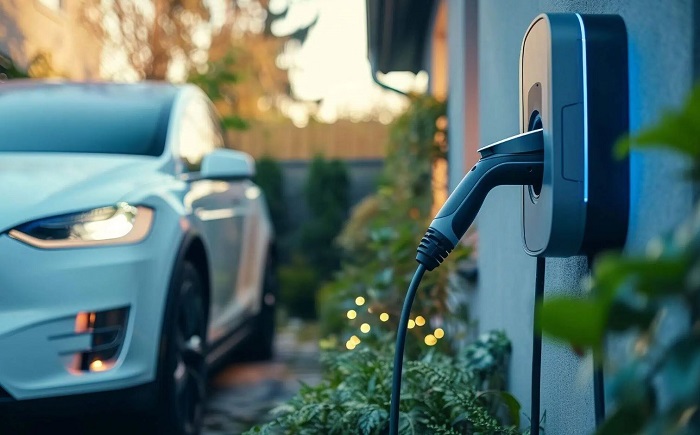
- Regular Maintenance Tips for NEMA 14-50 Plug and Outlet:
Visual Inspection: Periodically inspect the NEMA 14-50 plug, outlet, and wiring for signs of damage, wear, or corrosion. Look for loose connections, frayed wires, or burn marks, and address any issues promptly.
Cleanliness: Keep the plug and outlet clean and free of dirt, debris, or any obstructions that may hinder proper connection or cause overheating. Use a dry cloth or compressed air to remove dust and dirt.
Tighten Connections: Check the terminal connections on the outlet and plug to ensure they are tight and secure. Loose connections can lead to overheating and electrical arcing. Use a screwdriver to tighten terminal screws if necessary, but be careful not to over-tighten.
Check GFCI Functionality: If your NEMA 14-50 outlet is equipped with a Ground Fault Circuit Interrupter (GFCI), test its functionality regularly according to manufacturer instructions to ensure proper protection against electrical hazards.
Inspect Cable: Examine the charging cable for any signs of wear, damage, or fraying. Replace the cable if there are visible signs of damage to prevent safety hazards.
- Troubleshooting Common Issues with NEMA 14-50 Plug Charging:
No Power: If the EV charging station does not receive power when plugged into the NEMA 14-50 outlet, check the circuit breaker to ensure it has not tripped. If the breaker has tripped, reset it and try again. If the problem persists, check for loose or damaged wiring connections and consult a qualified electrician if needed.
Intermittent Charging: If charging stops intermittently during a charging session, check for loose or overheating connections at the outlet, plug, and charging cable. Ensure that all connections are secure and properly tightened.
Overheating: If the NEMA 14-50 plug, outlet, or charging cable becomes hot to the touch during charging, immediately stop charging and inspect for loose connections, damaged wiring, or obstructions. Overheating can indicate an electrical issue that requires prompt attention.
Faulty Grounding: Ensure that the NEMA 14-50 outlet is properly grounded to prevent electrical hazards. If you suspect a grounding issue, consult a qualified electrician to inspect and correct the grounding connection.
- Safety Practices for Maintaining NEMA 14-50 Plug Charging Setup:
Turn Off Power: Always turn off power at the circuit breaker before performing any maintenance or troubleshooting tasks on the NEMA 14-50 plug and outlet to prevent electrical shocks or hazards.
Use Protective Gear: Wear appropriate personal protective equipment, such as insulated gloves and safety glasses, when handling electrical components to protect against electrical hazards.
Follow Manufacturer Instructions: Adhere to manufacturer instructions and safety guidelines when performing maintenance, troubleshooting, or repairs on the NEMA 14-50 plug, outlet, and charging equipment.
Consult a Professional: If you encounter any issues with the NEMA 14-50 plug charging setup that you are unsure how to resolve, or if you suspect an electrical problem, seek assistance from a qualified electrician to ensure safety and proper resolution of the issue.
Additional Tips:
- Consult your EV charger’s manual for specific maintenance recommendations.
- Consider surge protection for your EV charger to safeguard against voltage spikes.
By following these tips, you can ensure the safe and efficient operation of your NEMA 14-50 plug charging setup for years to come. Remember, prioritize safety and avoid any electrical work you’re not comfortable with. Leave it to a licensed electrician for peace of mind.
Regulations and Standards
Compliance requirements, safety standards, and regulatory guidelines play crucial roles in ensuring the safe installation and operation of NEMA 14-50 outlets and EV charging infrastructure.
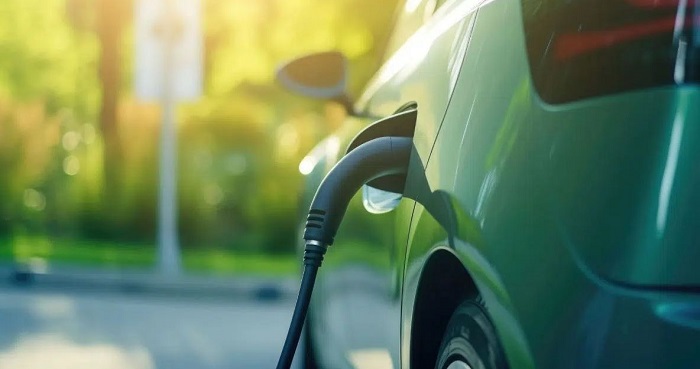
Compliance Requirements for Installing a NEMA 14-50 Outlet:
- National Electrical Code (NEC): The NEC sets the baseline safety standards for electrical installations in the United States. A qualified electrician will ensure your NEMA 14-50 outlet installation adheres to the relevant NEC codes.
- Local Permits: Most localities require permits for installing high-voltage outlets like NEMA 14-50. Obtain the necessary permits before starting the installation process.
Safety Standards for EV Charging Infrastructure:
- UL Listed: Look for EV chargers that are UL listed. This indicates they have undergone rigorous testing and meet safety standards established by Underwriters Laboratories.
- GFCI Protection: While not always mandatory by code for EV chargers, a Ground Fault Circuit Interrupter (GFCI) can provide additional protection against electrical faults. Consult your electrician about GFCI implementation.
Regulatory Considerations for Using the NEMA 14-50 Plug in Different Regions:
- United States: The NEC serves as the primary guideline, with additional local regulations potentially applicable.
- Canada: The Canadian Electrical Code (CEC) sets the standards for electrical installations. It’s similar to the NEC but with some variations.
- Europe: The International Electrotechnical Commission (IEC) publishes standards for electrical equipment, including EV charging. Specific regulations may vary by country within Europe.
It’s crucial to comply with regulations and safety standards in your specific region. While this information provides a general overview, always consult with a licensed electrician familiar with local codes for NEMA 14-50 outlet installation for EV charging. They can ensure your setup meets all safety requirements.
Future Trends and Innovation in NEMA 14-50 Plug Charging for EVs
As electric vehicle (EV) adoption continues to grow, the evolution of NEMA 14-50 plug technology for EV charging is likely to include advancements aimed at improving convenience, efficiency, and sustainability.
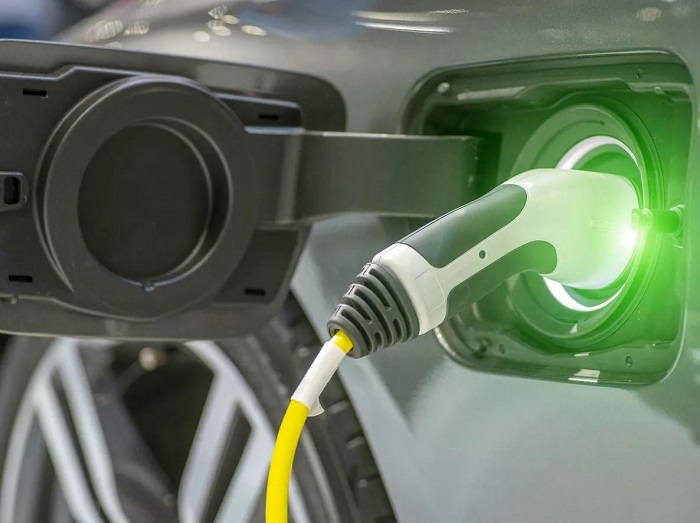
NEMA 14-50 Plug Technology Evolution:
- Focus on Safety and Efficiency: We might see improvements in materials and design to enhance the plug’s durability, heat resistance, and overall efficiency for handling EV charging loads.
- Standardization and Interoperability: While the core design is unlikely to change drastically, there could be efforts to further standardize features and functionalities across different NEMA 14-50 EV charger models for a seamless user experience.
Integration of Smart Features:
- Smart Charging Integration: NEMA 14-50 chargers might become more integrated with smart home systems, allowing for optimized charging based on factors like time-of-day electricity rates or solar energy availability.
- Real-Time Monitoring and Diagnostics: Advanced chargers could offer real-time monitoring of charging status, battery health, and potential fault detection for preventive maintenance.
- Voice Control and App Integration: Voice assistants and smartphone apps could be used to control and monitor NEMA 14-50 EV chargers remotely, enhancing convenience.
Sustainability in NEMA 14-50 Plug Charging:
- Integration with Renewable Energy Sources: Future setups might allow NEMA 14-50 chargers to prioritize charging from renewable sources like solar panels installed at home, promoting sustainable EV charging practices.
- Energy-Efficient Charging Modes: Advancements could lead to more efficient charging algorithms within NEMA 14-50 chargers, minimizing energy loss during the charging process.
The NEMA 14-50 plug is likely to remain a relevant and reliable option for home EV charging in the foreseeable future. However, we can expect advancements in smart features, integration with renewable energy sources, and a continued focus on safety and efficiency to shape the future of NEMA 14-50 EV charging setups.

Henry Michael is a leading expert in EV charging station research, specializing in innovative solutions for electric vehicle infrastructure. With a passion for sustainability and technological advancement, he is dedicated to advancing the accessibility and efficiency of EV charging worldwide.

